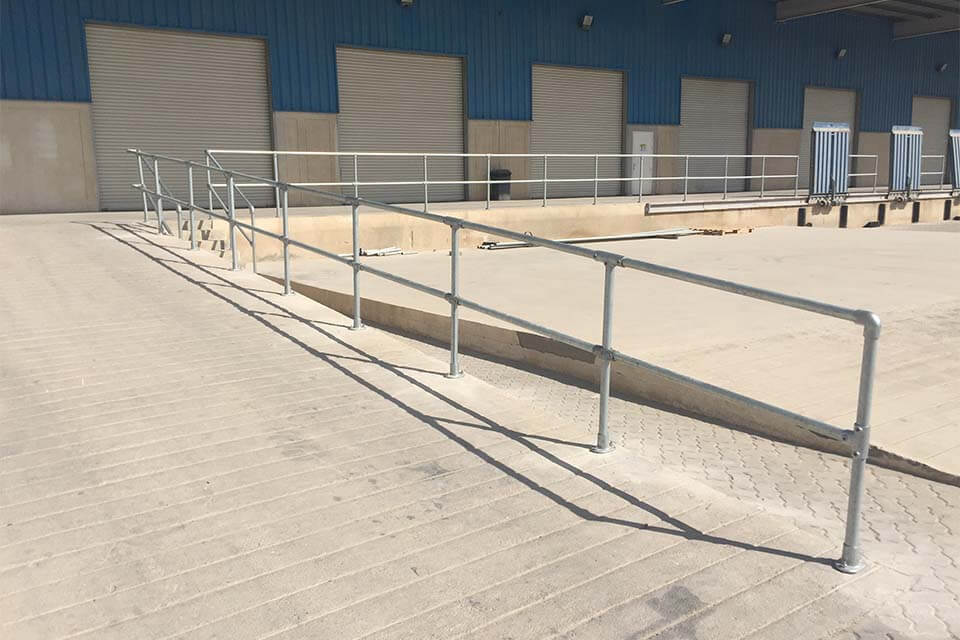Loading Dock Guardrail Buyer's Guide

Your loading dock has some of the most important traffic for the success of your business. This much traffic means a lot of exposure to hazards, falling off the loading dock.
Preventing someone from falling off the loading dock is as simple as installing a guardrail.
Here are 4 questions that will help you know that you’re picking the right option.
Will the Guardrail Meet Loading Dock Railing Requirements?
OSHA details the requirements for guardrails in more detail since the 2017 update. However, OSHA 1910.29 repeats itself a lot and it can be a little confusing to sort through.
Here is a summary to make it easy for you:
- The top rail must be 42 inches in height, give or take 3 inches.
- The top rail must be able to withstand 200lbs of force in the downward and outward direction.
- A midrail should be installed midway between the top rail and the surface.
- Additional midrails should be added as needed to make sure there is no opening greater than 19 inches.
- The midrail should be able to withstand 150lbs of force in the downward and outward direction.
- Do not create projection hazards with any rails extending beyond terminating posts.
We built a guide for OSHA compliant guardrails If you’d like to dig deeper into this.
The ADA will want to make sure those with disabilities have safe means of accessing the work zone, if applicable. We put a guide together to help you navigate the ADA code and determine if and how it applies to you.
Also, check with your local building code if you’re doing anything that requires a permit and inspections.
A Kee Klamp mounted guardrail will meet OSHA standards and can be designed to meet ADA requirements and local building codes. It can even be modified after installation to meet new requirements that come up.
How easy is it to design?
Not every loading dock is made equal. You may have long ramps that slope down towards your dock. Or maybe you have a long exterior dock with multiple load points and access stairs.
No matter how simple or complicated your loading dock is, you want a guardrail that can easily conform to the layout and your work needs. Pre-welded panels can pigeonhole you into specific configurations or potential leave blank spaces that someone or something could fall through.
You should be able to design the guardrail yourself, if you choose, and still know that it's compliant with any applicable standards.
How Easy is the Loading Dock Railing to Install?
Being able to DIY the guardrail will give you a lot of freedom around the time that the railing gets installed. How many times have projects been delayed because a contractor was behind on a project?
You want a guardrail that is so easy that the new guy can install it. Here are a few questions that you can answer to see how much complication the guardrail will add to your project:
Is a Hot Work Permit required?
This could add days and weeks to your project as you wait for the permit to be approved and for the inspections to happen. This also adds money as you may have to pay for these inspections and for the expertise of a welder.
What tools are needed to install the guardrail?
This could be as simple as needing a torque wrench, Sawzall, and hammer drill, which is all that is needed for a Kee Klamp railing. Or you may need large diamond core bits with an appropriately large drill to core into the concrete.
What happens if the guardrail doesn’t fit?
Sometimes you have to move the location of the guardrail during installation. Maybe someone forgot to work around a support beam for the dock canopy. Or it could be that a process has changed overnight, and the layout now needs to change.
Our component-based guardrail will allow you to make these changes on the fly. You don’t have to worry about sending huge panels of guardrail back by freight and waiting for the replacements to arrive. Kee Klamps are small and can be easily shipped overnight to help you finish your project on time.
The answers to these questions could determine if you have removed stress induced headaches or added them.
How will you protect the loading areas?
A very common question is what to do with the empty space in the guardrail where the trucks are being loaded. After all, it’s not efficient or safe to try to unload a truck by handing product over a mounted handrail. I’m picturing that now. So much can go wrong.
Here are the 3 options you can use.
Safety Gate
A safety gate is the most effective option for protection because it requires the least amount of work with the strongest protection. You can also build one yourself if you use the correct swivel fittings. Any gate that you use must provide safety equivalent to a guardrail.
Loading Dock Safety Chains
A chain can be used, but like with safety gates, needs to be able to provide the same level of safety as a guardrail. Most of the time, I don’t see this happening. The top rail (or chain) must not deflect to a height lower than 39 inches. Most chains I’ve seen sag 5+ inches. Also, as shown above, multiple chains will need to be used so no opening is greater than 19 inches. This is the option with the greatest margin of error.
Removable Loading Dock Railing
Removable rails do not have the sag issues of chains. They also don’t have the ease of safety gates. This will depend on how the removable rail was designed. It should include some form of locking mechanism, like a set screw, so that it doesn’t slide or fall out, exposing the hazard.
How Easy Will the Guardrail be to Maintain?
Grabbing some lumber from your local shop to slap a railing together can be very tempting. However, how long will that last before you have to replace it again? What happens if a forklift, pallet jack, or truck bumps into it?
Galvanized steel or aluminum systems will last much longer. After all, we’re trying to get things off your plate, not snooze the problem like your morning alarm.
If something happens to damage the guardrail beyond normal wear and tear, then you want a guardrail that can be spliced into quickly. Wood can do this very easily, but do you really want to do this over and over...and over again?
Our component-based guardrail systems will be easier to repair if something happens. Just cut the pipe and attach the new fittings and voila, you have a fixed guardrail. Also, you don’t have to wait for the store to open because you can buy the pipe and fittings you need online.
Wrapping Up
Getting your people home at the end of the day in good health is important. It’s one important thing of many on your plate...today. You don’t have to take all of this on by yourself.
Let us help you relieve some of your stress by getting the loading dock railing that you need.


